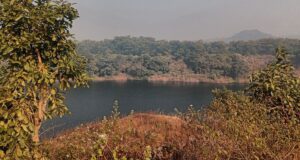RAHUL SINGH
Bokaro, Jharkhand: Pichri coal mine in Dhori mining area of Bokaro has remained closed for many decades. Now an uninhabited forested area, the mine has become a deep pool where people from surrounding areas catch fish.
At the site, three women were seen coming out of the bushes with baskets of coal dust. One of them responded to the queries saying they were residents of neighbouring Jamtand Colony. “We use this [coal dust] for household work,” she said uneasily. “We do this work only to meet our domestic needs, and not for livelihood,” she clarified repeatedly.
A dilapidated housing quarter of the Central Coalfields Limited (CCL) is in the vicinity. Showing the area, Shravan Singh (40), a daily wage coal loader, said, “Our family also lived here, but moved out to the nearby Pichri Bangla Basti after the mine closed. The next generation of the then permanent coal workers are now unorganised coal labourers.”
Unlike the previous generation, Shravan does not get loading work every day. “I do not have a permanent job, I somehow live by working as a house maid,” lamented Muniya Devi (45), another resident.
Siyaram Singh (52) of the same locality said the coal mine stopped operations in 1976, and they were settled in the present accommodation in 1983. Some families were settled in Tungri Kulhi, Jamtand and Rohaniadih also.
Most of the coal mines of Bokaro have such settlements where residents have no option but to look up at unorganised and uncertain employment in the coal mining industry for their livelihood. This pushes many into unsafe and illegal mining, which poses a risk of accident and death. Such incidents are particularly high in Bokaro and Dhanbad districts as they are old mining areas where a large number of mines are no longer mined.
The situation at Angwali — about 14 km from Pichri and also falling under Dhori mining area — is no different. “The conflict and battle for supremacy among the local leaders stopped mining here,” informed Lalan Soni, a villager.
Also Read- Jharkhand News: New lifeline for over 3000 assistant teachers
In 1972, CCL acquired 210 acres at Angwali North Panchayat in Petarwar block of Bokaro district. When the mine was running, about 400 people got direct [there was no contract job then] employment. When it stopped operations in the 1980s, workers were sent to Kalyani and Amlo projects.

Who is responsible?
Kashinath Kewat, general secretary, Visthaapit Sangharsh Samanvay Samiti, which is active in the Bokaro coal mining area, told 101Reporters that Pipradih, Jhirki and many other mines in Bermo and East Bokaro coalfields have been closed.
“First the land of the local farmers were acquired for mining, due to which they became dependent on the coal industry. When the mines closed down, it led to a bigger crisis,” he said. Many have switched to illegal mining, making themselves vulnerable to action from police and the patrolling party of the Central Industrial Security Force (CISF).
“Illegal mining from closed mines is risky. If they are operated again, such risks can be prevented,” hoped Damodar Mishra, a resident of Angwali. Kewat also claimed they have recommended the reopening of closed mines to the CCL to ensure safe and scientific mining.
“It should be done more so to protect the interest of local communities than the permanent workers as their entire livelihood has been snatched away,” said Coalfield Mazdoor Union general secretary Raghavan Raghunandan.
However, in response to a question about illegal mining, Coal Minister Prahlad Joshi told Parliament that it is a law and order issue, which is a state subject. The reply said it was primarily the responsibility of the state government and district administration to take action.
Bokaro District Mining Officer Ravi Kumar told 101Reporters that it was primarily the job of CCL to stop illegal mining because CCL is the custodian of such mines and mining areas. Also, it has the service of CISF at its disposal. “However, we [district administration] still take action from time to time,” he added.
Meanwhile, a CCL official admitted that it was their duty to stop illegal and unsafe mining.
Self-employment option
The CCL provides NGOs with corporate social responsibility funds to provide alternative employment to coal workers in some areas. However, people whom this reporter spoke to believed that income from self-help groups or other small employment options such as poultry units cannot be an alternative to the coal income. People are finding employment elsewhere, but the coal industry still seems to be a better and easier option for them.
Bokaro is the third highest recipient of District Mineral Foundation Trust (DMFT) deposits after West Singhbhum and Dhanbad. According to a Parliament document, Bokaro district received Rs 83.8 crore under DMFT head in 2020-21 and Rs 139 crore in 2021-22. With the fund, water, power and road connectivity are ensured in mining affected areas, besides training coal workers for alternative employment.
Under the Pradhan Mantri Khanij Kshetra Kalyan Yojana, at least 60% of the DMFT deposit has been allocated to high priority areas such as drinking water supply, healthcare, education, environmental preservation and pollution control, welfare of women, children, the aged and differently abled, skill development and sanitation.
However, Angwali North Panchayat mukhiya Dharmendra Kapardar told 101Reporters that no specific plan has been initiated for the development of coal areas. “The DMFT does some work, but it is insufficient. Jharkhand State Livelihood Promotion Society also holds training programmes for self-employment, but not very effectively,” Kapardar asserted, while reminding that local people needed employment.
Also Read- Jharkhand News: NPU Daltonganj gets Rs 20 crores under PM USHA
“Bokaro receives an average royalty of Rs 550 to 600 crore per year from mining, of which about 95% contribution comes from coal. Around Rs 150 to 180 crore is deposited annually with the DMFT,” said District Mining Officer Ravi Kumar.
Will mines reopen?
In May 2022, Minister Joshi said that the extractable reserve in closed/discontinued coal mines was approximately 380 million tonnes (MT), of which 30 to 40 MT could be easily extracted. He also shared a plan to offer 20 closed/discontinued underground mines to the private sector on a revenue sharing model.
Before that, in a written reply to a question in the Lok Sabha on February 3, 2021, the minister said, “Coal India Limited and its subsidiaries have planned to open 22 new coal mines.” Of the eight such mines from Jharkhand mentioned in the reply, six belonged to CCL. The area of forest land to be used up for each mine was also mentioned. For example, 23.02 hectares of forest land was to be used for Pichri opencast mine.
“Pichri is a very old mine… Forest land is only a small part of the total mining land. It is yet to be verified how much land has been acquired,” said Bokaro AITUC leader Lakhanlal Mahato.
In a Gazette notification, the Ministry of Coal also mentioned acquisition of 53.02 hectares for Pichri mines under the Coal Bearing Areas (Acquisition and Development) Act, 1957.
However, three years since the government’s response, no mining work has begun. The Central Mine Planning and Design Institute Limited refused to respond to a Right To Information application filed by this correspondent regarding the plan to extract coal from abandoned and discontinued mines.

Rehabilitation measures
Minister Joshi told the Lok Sabha on December 13 last year that a total of 13,709.44 hectares (33876.76 acres) have been acquired for CCL coal mining areas of Kathara, Dhori and Bokaro-Kargali.
According to government figures, 1,043 families have been displaced/affected by coal mines. On whether the displaced families have been employed, the reply said 1,014 jobs have been provided since 1985. “Most of the hutment settled on GM [gair mazrua] land which tenant does not have any valid documents claiming their land [sic]. These villagers are demanding house compensation as well as land compensation,” the reply stated.
According to Coal India Limited (CIL) policy, there is a provision to provide one job per two acres of acquired land. Accordingly, over 16,000 jobs should have been created. However, the actual numbers are much lower. On this, Joshi’s reply stated that disputes within the family regarding claim of employment, and employment claims by the affected persons beyond norms (means seeking employment without fulfilling all conditions) are among the obstacles. Coal companies have allowed small landowners to club their small portions of land to make two acres for employing one nominee.
According to the data available till April 1, 2021, 284 CIL mines have been closed/abandoned/discontinued. Of them, 29 belong to CCL. The biggest problem in restarting mines is in getting land. The company arrives at a decision by checking the coal reserves available and assessing whether it will be profitable to mine the area.
The Coal Ministry recently accepted that mine closure processes have historically been uncontrolled. As per the statement, 169 pre-2009 mines and 130 post-2009 mines are considered closed, abandoned and terminally closed. Of these, 68 mines built before 2009 have been marked for final closure. In 2009, for the first time, the Coal Ministry issued guidelines for closure of mines that are not in use. However, only planning has happened so far.
“Bermo coalfield-related projects took up large chunks of land over decades. About 6,000 acres were allotted for Damodar and Rail Diversion Project. Neither the project materialised nor the land was suitable for farmers anymore. Unusable mines and unused land should be diverted for farming and installation of solar panels,” said Mahato.
Also Read- Maharashtra: Bill for 10% quota to Marathas approved by state govt
The government’s emphasis is on maximum coal exploitation as it believes that there cannot be growth without energy, and that coal is its main source of energy. Contrary to its just transition plan, India’s coal production is increasing rapidly. This is why the country talks about phase down, not phase out.

(Rahul Singh is a Jharkhand-based freelance journalist and a member of 101Reporters, a pan-India network of grassroots reporters.)


